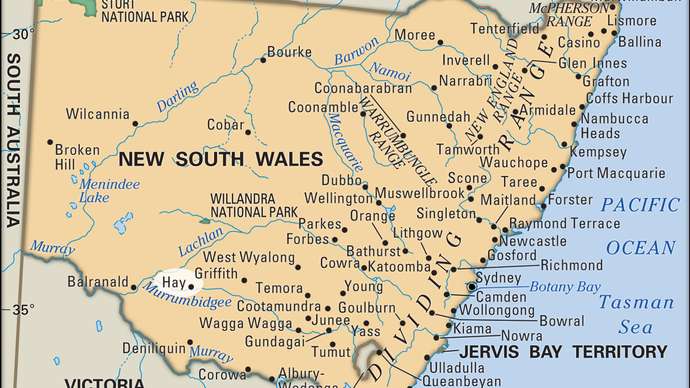16. May, 2021
The Township of Hay
HAY NSW
The settlement originated in 1840 as a coach station known as Lang’s Crossing Place. It was surveyed in 1858 and became a town the following year, named for John Hay, a district parliamentary representative. Developed as a river port, it was proclaimed a municipality in 1872 and a shire in 1965. Hay is situated at the junction of the Stuart, Cobb, and Mid Western highways. It now serves a wide area (of the far-western Riverina) of semiarid sheep grazing irrigated-fruit and dairy cotton and almond treees.
Where We Came From
The present site of Hay was located at the junction of four large 'squatter' properties, one of which was occupied by the Lang Brothers where an important river crossing was located. Stockmen would frequently camp at the site before crossing the river with their stock and even now the area is known as Lang,s Crossing.
In 1858, river steamer Captain Francis Cadell built a store at the crossing, which was soon followed in 1859 by a punt service and hotel built by American Henry Leonard.
The township of Hay was named after Sir John Hay, a local pastoralist and Member of Parliament, after the town was gazetted in 1859.
Development of the town progressed with the original courthouse (the site of the present post office) built in 1860. Soon after, Cobb & Co. made Hay the headquarters for their Victoria and Riverina operations and then set up a coach factory at the corner of Lachlan and Randall Streets which became the largest coach factory in Australia outside Sydney.
In Hay, heritage is interwoven with contemporary life
Hay's history is rich with characters and tales of boom and bust - of isolation and innovation. Visitors are welcome to explore the town's unique history by following a heritage walk, dropping into the local history section of the Hay Library, visiting one of our five museums, or simply taking a stroll around our streets, parks and riverside reserves.
Our heritage places
Hay has many special heritage places where visitors can immerse themselves into the past, from the spectacular 1892 courthouse to the imposing railway station, evocative cemetery and much loved Sunbeam Cobb & Co coach.
In earlier years it was thought Hay would become the capital of the Riverina, which has left the town with a grand legacy of Australian architecture. The many heritage buildings reveal the ingenuity of early architects attempting to tame a harsh outback climate.
Family History:
Hay's significance as a crossroads means many families have links to the town. Many visitors attempt to trace family history to provide links to the past. Perhaps tracing a POW father, shearing grandfather, schoolteacher cousin, railwayman great grandfather, or Chinese market gardener uncle, or find out more about family member's time here as a nurse, soldier, cook, stockman or shopkeeper.
In more recent times, the Australian Shearers' Hall of Fame was adopted by the local community, and in January 2002, Shear Outback opened .
Visiting the Hay region has an enormous amount to offer visitors and locals alike.
